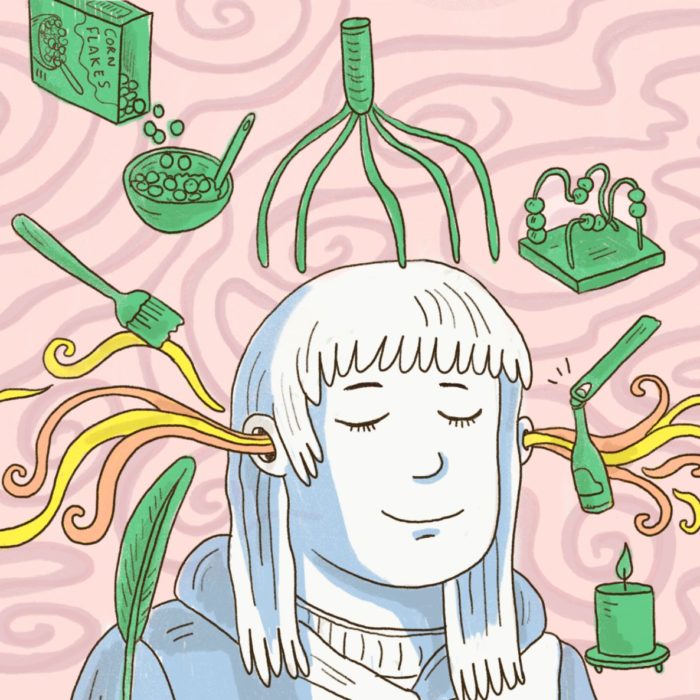If you’re like me you’ve seen videos circulating on social media of people biting into potato chips in front of a microphone. Kids these days will do anything to catch a few followers on Instagram. The trend is called ASMR or Autonomous Sensory Meridian Response. That’s a very fancy term for the tingles. Many people report getting a tingling sensation from the head and moving to the spine as they hear certain trigger sounds. Personally the sound of potato chips has always made my stomach rumble, not my head tingle.
YouTube user ASMRPhan has 2.2 million followers
One night, having a particularly difficult time getting to sleep, I jumped on YouTube to find something to help transport me to dreamland when I stumbled upon the labyrinth that is ASMR. Why not give this a shot, I thought? Maybe this will help me fall asleep? My ASMR of choice to cure my insomnia was the rustling of papers in a cafe and before you know it that beautiful tingling spread through my scalp and down my spine and I fell asleep and had an excellent night’s sleep.
This video of paper shuffling sounds has almost a million views.
The next day I was curious for more. I have long been a supporter of meditation so this seemed like a close relative. I wondered, could I throw away the bag of potato chip sounds and actually use ASMR for something? What about the creative slump I was going through? If it can help me fall asleep maybe it could also help get my creative juices flowing? I decided to try ASMR centered meditation two times a day for a week and record my observations. Once in the morning before starting out the work day, and once in the evening to help me fall asleep.
Not all ASMR is outlandish. ASMR has definitely been the punchline of a lot of internet jokes (perhaps rightfully so). Social media tends to highlight the more wild and humorous aspect. In my research lots of videos were centered around people whispering and many others on simple noises such as tapping and scrapping. Other ASMR videos had more complex sounds, such as real recording in cafes and restaurants. Is there actually something to this? People seem to agree that the sound of rain and the crashing of waves is calming. There is even a whole branch of therapy called sound therapy.
The way many people whisper in ASMR videos resembles the voice of Ralph Fiennes as Lord Voldemort, as this hilarious video from YouTube so pointedly demonstrates
I decided to try a variety of ASMR triggers to see which would suit me. The first day I tried the sounds of nails on a wood table. I listened for 15 minutes (which felt like an hour) but I didn’t feel any tingling. Perhaps I only imagined I had experienced ASMR the night before? Maybe it was simply my fatigue. In any case, I carried on with my day: a normal, boring, nothing outlandish kind of grey spring day.
What I have learned is that different sounds trigger different people. I definitely prefer sounds like cafes and restaurants which are more similar to white noise. The sound of sponges being rubbed together doesn’t do anything for me. Although I do have an odd affection for papers being shuffled and magazines pages. These sounds also provoke images in my mind of crisp fall days going back to school as a kid.
This type of YouTube video by ASMR weekly is my preferred stimulus of choice.
A few days in I decided to ditch YouTube. I realized I had an entire live concert of ASMR at my fingertips. This was probably one of my favorite things about my experience. When I stopped and sat down on a park bench I realized the richness of sounds that surround us all the time that we take for granted. The sound of leaves being blown across concrete reminded me of the fingernails on wood. The sounds of the gardeners rake sounded like the rough sponges being grated. In a cafe, I realized that the sounds of silverware being tossed around are very melodic. My biggest ASMR trigger is simply sitting at my desk next to my open window listening to traffic.
A recent study published in the scientific journal PLoS ONE showed that people who reported experience ASMR also had reduced heart rate levels. The studies go on to say that provoking ASMR could have benefits on mental and physical health.
For me, ASMR seems to be a somewhat elusive result and a close relative of mindfulness and meditation. Mindfulness and meditation require focusing on your sensory perception. For instance, in meditation you focus on your breathing, your body weight on the yoga mat, and yes, the sounds around you. I am also curious to know if I feel the tingling sensation in the scalp because I am anticipating it. Although I am no scientist I feel like I could give you a placebo that I could claim would make your feet tingle and you would report a tingling sensation. In the end, my pseudo-scientific anecdotal experiment leaves me scratching my tingling head and leaves more questions than answers.
And what about my creativity? Did I write something brilliant? Did I paint a magnum opus?
Although it’s hard to say for sure I will say that I did get plenty of good rest and I was productive throughout the week. Who is to say that I wouldn’t have been equally productive without the quirky soundtrack. It’s pretty clear that ASMR didn’t hurt. My biggest takeaway was my newfound appreciation for the sounds around me. Would I recommend you try it and see for yourself? Sure, open up a bag of chips and find yourself a video on YouTube.



